C. Litka's Blog, page 65
July 4, 2016
New Cover Art for The Bright Black Sea
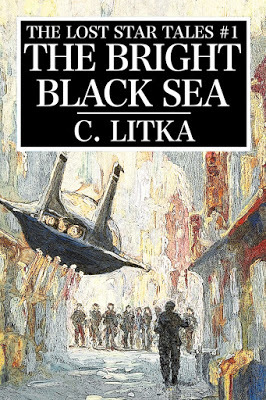
I've uploaded new cover art for The Bright Black Sea for the Amazon edition. This actually (if far from ideally) illustrates a scene from the story. As I've mentioned, I don't really have anything more than an impression of the scenes I write, so that I'm left with constructing one limited by my artistic talents. Luckily, gimp provides digital tools to greatly enhance my efforts. Trust me, the original of this is really bad.
I will be updating the cover of my other editions shortly.
I've also changed the name of the series to The Lost Star Tales, with The Bright Black Sea being volume #1, at least for now. I am somewhat torn in that the Volume #1 could be considered a collection of the first three tales and The Lost Star Tales #2 will be only one tale, so it should be more accurately numbered #4 since it will be only the first episode in the full story of Wil Litang's adventures and misadventures in the Archipelago of the Tenth Star. The complete work, The Lost Star's Sea will likely be as long as The Bright Black Sea. However, since I don't see that project being completed before mid to late 2017, The Lost Star Tales #2, Castaways of the Lost Star will be a stopgap measure, consisting of the opening tale or episode of the larger book. I'll be posting more details on that in the coming days.
Once I have the #2 in the series out, we'll see if Amazon will let me once more list The Bright Black Sea for FREE. I believe they allow authors to give away the first book in a series to prime the pump for the rest of the books. I'm going to have to look into that once I have Castaways of the Lost Star listed.
Published on July 04, 2016 09:22
June 25, 2016
It Has A Name
The name is aphantasia.
In the blog post where I talked about the failed covers of The Bright Black Sea, I mentioned that I could not picture peoples' faces in my head, or indeed, as I explored my mind more, that I could not picture anything clearly in my head. At best I'd “see” a vague impression, from which I might be able to piece by piece reconstruct an image. For example, I can probably draw a good picture of my house without looking at it, because I “know” what it looks like without actually “seeing” it in my mind, at least not as a complete image.
The reason why I mentioned this in the post was because I had considered a cover with characters on it, and rejected it for two reasons. The first was that I had no clear mental images of my characters. In my writing, you'll find few references to how they look, most are vague and you're free to ignore them, which reflects the fact that I don't have pictures of real people, people I see everyday and/or have known all my life, much less make believe ones. I could, I suppose, make a spread sheet of each character's physical characteristics, tall,/short, blond/black/brown/red hair, etc. and then just plug those features in when writing about that character, but since there appearance isn't important to me, I'd probably never think about doing it anyways.
The upside is that rather than try to compensate for this imaginative gap with a cheat sheet, I just outsource the job to you, my readers. You're free to imagine them anyway you like. Anyway they appear in your mind while reading about them goes. And that being the case, I didn't want to give them any physical appearance on a cover or interior art. They're yours to image.
A few weeks after that post, I came across an article that describes this condition of not being able to see images in one's mind, a condition called aphantasia.
The BBC article is here: http://www.bbc.com/news/health-34039054
I suppose there are degrees in every condition. I have no trouble finding my car in a parking lot, and I don't think I would even if it wasn't bright green. (My wife's choice.) I still can find my way aroundplaces I've visited in many years. And strangely enough, I'm pretty certain that I dream in fairly images, though that's a bit hard to say, because whileI retain the impression of images, I can't recall morethan an impression of thoseimages – the condition reasserts itself in my waking mind.
I found this interesting. I had realized longbefore this article that other people could recall events much more vividly in mind than I could, so the condition itself was no surprise, onlythat it was a diagnosed condition. I don't see it as any sort of handicap. I'm a painter, after all, and most of my paintings are strictly from “imagination”. While my later acrylics are often impressionistic, my earlier work is much more realistic. (There are a few samples of this style on my DeviantArt site.) In all of them, Iwasn't painting from what I could “see” in my mind, so much as taking an impression of a place,/time/moodand then engineering something like itontothe paper or board – and as often as not, into something different than what I set out to paint.
The one downside is that I don't get mymoney's worth as a tourist. I know I was there, but the only way to relive it, is to lookat the photos taken. I can not replay the sights and sounds in my mind over and over again, like other people can. Seeing that I hate to travel, that's no big deal, though I wonder if this inability to relive the experience has something to do with my disinclination to travel. What's the cart, what's the horse? And since Ican easily find plenty of photos of everywhere, and view many places on street view, going so place to take pictures, and putting up with all the wear and tear and stress of travel is not worth it.
In the blog post where I talked about the failed covers of The Bright Black Sea, I mentioned that I could not picture peoples' faces in my head, or indeed, as I explored my mind more, that I could not picture anything clearly in my head. At best I'd “see” a vague impression, from which I might be able to piece by piece reconstruct an image. For example, I can probably draw a good picture of my house without looking at it, because I “know” what it looks like without actually “seeing” it in my mind, at least not as a complete image.
The reason why I mentioned this in the post was because I had considered a cover with characters on it, and rejected it for two reasons. The first was that I had no clear mental images of my characters. In my writing, you'll find few references to how they look, most are vague and you're free to ignore them, which reflects the fact that I don't have pictures of real people, people I see everyday and/or have known all my life, much less make believe ones. I could, I suppose, make a spread sheet of each character's physical characteristics, tall,/short, blond/black/brown/red hair, etc. and then just plug those features in when writing about that character, but since there appearance isn't important to me, I'd probably never think about doing it anyways.
The upside is that rather than try to compensate for this imaginative gap with a cheat sheet, I just outsource the job to you, my readers. You're free to imagine them anyway you like. Anyway they appear in your mind while reading about them goes. And that being the case, I didn't want to give them any physical appearance on a cover or interior art. They're yours to image.
A few weeks after that post, I came across an article that describes this condition of not being able to see images in one's mind, a condition called aphantasia.
The BBC article is here: http://www.bbc.com/news/health-34039054
I suppose there are degrees in every condition. I have no trouble finding my car in a parking lot, and I don't think I would even if it wasn't bright green. (My wife's choice.) I still can find my way aroundplaces I've visited in many years. And strangely enough, I'm pretty certain that I dream in fairly images, though that's a bit hard to say, because whileI retain the impression of images, I can't recall morethan an impression of thoseimages – the condition reasserts itself in my waking mind.
I found this interesting. I had realized longbefore this article that other people could recall events much more vividly in mind than I could, so the condition itself was no surprise, onlythat it was a diagnosed condition. I don't see it as any sort of handicap. I'm a painter, after all, and most of my paintings are strictly from “imagination”. While my later acrylics are often impressionistic, my earlier work is much more realistic. (There are a few samples of this style on my DeviantArt site.) In all of them, Iwasn't painting from what I could “see” in my mind, so much as taking an impression of a place,/time/moodand then engineering something like itontothe paper or board – and as often as not, into something different than what I set out to paint.
The one downside is that I don't get mymoney's worth as a tourist. I know I was there, but the only way to relive it, is to lookat the photos taken. I can not replay the sights and sounds in my mind over and over again, like other people can. Seeing that I hate to travel, that's no big deal, though I wonder if this inability to relive the experience has something to do with my disinclination to travel. What's the cart, what's the horse? And since Ican easily find plenty of photos of everywhere, and view many places on street view, going so place to take pictures, and putting up with all the wear and tear and stress of travel is not worth it.
Published on June 25, 2016 08:59
June 7, 2016
The Financial Realities of Writing
Early in May 2016 I posted a blog entry that set out my first year experiences in self-publishing. View it here:http://clitkabooks.blogspot.com/2016/05/a-window-to-self-publishing.html
In it I listed download totals and reviews, and set them in the context of books sales in general, and ebook and self-publishing on Amazon in particular. I hoped at the time to suggest that books sell in far few numbers than most readers would suspect and that authors, in general, make far less money than most readers would suspect. Most writers who are not writing for hire, but working on their own writing projects, will not make a living on writing. It's a part time job, or a full time job that pays part time wages.
The latest Author Earning report was recently released that analyzes Amazon book sales. You can find the full report here: http://authorearnings.com/report/may-2016-report/
One takeaway is that they found less than 10,000 authors making more than $10,000 a year from paper, audio and ebook sales combined on Amazon. Amazon sells about half the traditionally published books in the US and about 85% of the non-traditional books, i.e. self-published or indie-published books.
In the comment section, the Data Guy, the fellow who compiles the data, set out to explain why there are so few writers who are making $50,000 a year writing (something like a living wage).
“Americans spend about $15 billion a year on trade books of all formats. After retailers and publishers take their cut, at most $3 billion actually lands in author pockets. Divided up perfectly evenly, that $3 billion could theoretically support 60,000 authors at the $50,000 level…
But instead, it’s getting divided up among at least 1,000,000 authors, if not more… including the estates and heirs of deceased authors. (I can see at least a million author names in our Amazon ebook data and top-selling Amazon print-book data, and that doesn’t even start to include the 32 million(!) lower-selling print book titles listed on Amazon right now, whose sales are too low to be captured in one of our scrapings.).But lets imagine that there were only a million authors sharing the $3 billion right now. Which is an average of $3,000 each, if it were evenly distributed — but of course, it isn’t evenly distributed. Not even close.It’s a Pareto distribution. And it’s one where the top 1% of authors — the top 10,000 — take home 50% of that $3 billion, making the average income among those top 10,000 authors around $150,000 a year. Here’s the thing, though: averages are pretty meaningless in a Pareto distribution. Because the top 1% of that top 1%, or just the top 100 authors — folks like James Patterson, Danielle Steel, Stephen King, Janet Evanovich, and the like — take half of the half. (Those 4 names alone account for 10% of it, if you believe Forbes magazine’s estimates.)So the remaining 9,900 authors in the top 1% have to split what’s left: $750 million. And the next 10% down — or 1,000 of them — take nearly 50% of that, leaving only $375 million to be split among the remaining 8,900 top-1%-ers, bringing their average income to $43,000 or so. Which means that every single author below that top 10,000 — and the majority of those in it — are actually earning less than $50,000 a year from their writing.All of which is a painfully longwinded way of saying that there just aren’t enough dollars being spent on books in the US to make “tens of thousands” of $50K-earning authors even a remote possibility.Throw in foreign sales (again, concentrated in the top few thousand traditionally-published authors) and movie rights (which, again, are mostly going to the top 1% of 1% of traditionally-published authors) and we could maybe talk ourselves up to high single-digit thousands of authors earning $50K....Anyone who sets out with an expectation of earning a living from their writing is setting themselves up for almost certain disappointment. At best a low single-digit percentage of writers are ever able to. But that’s actually good news: before indie publishing became viable, the odds of doing so as antraditionally-published author were far worse — and for unpublished-but-querying traditional aspirants, basically infinitesimal.”As a boy and man, I wanted to be a science fiction writer. I wrote several novellas, a fantasy novel, planned some others and YA mystery, but I lacked the never-say-die attitude needed to make it through all rejection slips into traditional publishing. Still, looking back, I may've dodged a bullet, given the odds and the meager rewards of success. However, In my old age, I don't need to tackle the publishing business, and I don't need to make money, so that for me, these days are the ideal days to write. The long odds of getting traditionally published and the meager rewards (and they're even more meager these days) no longer matter. I can do it purely for fun. And that's why, given my druthers, I share rather than sell my books.
In it I listed download totals and reviews, and set them in the context of books sales in general, and ebook and self-publishing on Amazon in particular. I hoped at the time to suggest that books sell in far few numbers than most readers would suspect and that authors, in general, make far less money than most readers would suspect. Most writers who are not writing for hire, but working on their own writing projects, will not make a living on writing. It's a part time job, or a full time job that pays part time wages.
The latest Author Earning report was recently released that analyzes Amazon book sales. You can find the full report here: http://authorearnings.com/report/may-2016-report/
One takeaway is that they found less than 10,000 authors making more than $10,000 a year from paper, audio and ebook sales combined on Amazon. Amazon sells about half the traditionally published books in the US and about 85% of the non-traditional books, i.e. self-published or indie-published books.
In the comment section, the Data Guy, the fellow who compiles the data, set out to explain why there are so few writers who are making $50,000 a year writing (something like a living wage).
“Americans spend about $15 billion a year on trade books of all formats. After retailers and publishers take their cut, at most $3 billion actually lands in author pockets. Divided up perfectly evenly, that $3 billion could theoretically support 60,000 authors at the $50,000 level…
But instead, it’s getting divided up among at least 1,000,000 authors, if not more… including the estates and heirs of deceased authors. (I can see at least a million author names in our Amazon ebook data and top-selling Amazon print-book data, and that doesn’t even start to include the 32 million(!) lower-selling print book titles listed on Amazon right now, whose sales are too low to be captured in one of our scrapings.).But lets imagine that there were only a million authors sharing the $3 billion right now. Which is an average of $3,000 each, if it were evenly distributed — but of course, it isn’t evenly distributed. Not even close.It’s a Pareto distribution. And it’s one where the top 1% of authors — the top 10,000 — take home 50% of that $3 billion, making the average income among those top 10,000 authors around $150,000 a year. Here’s the thing, though: averages are pretty meaningless in a Pareto distribution. Because the top 1% of that top 1%, or just the top 100 authors — folks like James Patterson, Danielle Steel, Stephen King, Janet Evanovich, and the like — take half of the half. (Those 4 names alone account for 10% of it, if you believe Forbes magazine’s estimates.)So the remaining 9,900 authors in the top 1% have to split what’s left: $750 million. And the next 10% down — or 1,000 of them — take nearly 50% of that, leaving only $375 million to be split among the remaining 8,900 top-1%-ers, bringing their average income to $43,000 or so. Which means that every single author below that top 10,000 — and the majority of those in it — are actually earning less than $50,000 a year from their writing.All of which is a painfully longwinded way of saying that there just aren’t enough dollars being spent on books in the US to make “tens of thousands” of $50K-earning authors even a remote possibility.Throw in foreign sales (again, concentrated in the top few thousand traditionally-published authors) and movie rights (which, again, are mostly going to the top 1% of 1% of traditionally-published authors) and we could maybe talk ourselves up to high single-digit thousands of authors earning $50K....Anyone who sets out with an expectation of earning a living from their writing is setting themselves up for almost certain disappointment. At best a low single-digit percentage of writers are ever able to. But that’s actually good news: before indie publishing became viable, the odds of doing so as antraditionally-published author were far worse — and for unpublished-but-querying traditional aspirants, basically infinitesimal.”As a boy and man, I wanted to be a science fiction writer. I wrote several novellas, a fantasy novel, planned some others and YA mystery, but I lacked the never-say-die attitude needed to make it through all rejection slips into traditional publishing. Still, looking back, I may've dodged a bullet, given the odds and the meager rewards of success. However, In my old age, I don't need to tackle the publishing business, and I don't need to make money, so that for me, these days are the ideal days to write. The long odds of getting traditionally published and the meager rewards (and they're even more meager these days) no longer matter. I can do it purely for fun. And that's why, given my druthers, I share rather than sell my books.
Published on June 07, 2016 13:44
June 5, 2016
A Summer in Amber Version 3.1 released
Version 3.1 of A Summer in Amber is making its way out into the world. Thanks to daughter Nel, who highlighted the typos and missing commas she found while reading the story on her ipad and sending those notes on to me. With her help, I have eliminated a number of sloppy edits, and other typos in the first half of the Story. Stay tuned for Version 3.2, which will include the second half of the story, once Nel gets to reading that.
It does appear easy in iBooks to highlight any mistakes you find, which can then be easily emailed to me. In the email I only get just what is highlighted, so that if you highlight only the mistake, that, and the chapter it is in, is all I see, which can make some typos hard to locate. However, if you highlight several words before the typo to give me something to search for, I should be able to find and correct the mistake easily. I mention this only because if you would like to call mistakes to my attention, this is a very easy way to do it. I'm not sure how it works on the kindle, but it might work similar. The key, however, is to give the mistake a little context. I can usually figure out what is wrong on my own, so you need only to call my attention to the mistake to get it fixed.
Speaking of mistakes, I happened to be reading the back of my bag of potato chips the other day and came across this:
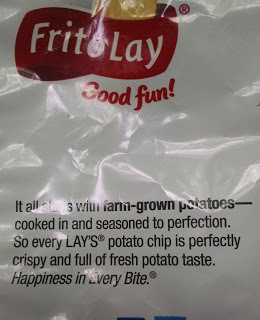
This is a photo of the back of a bag of “Lay's Classic Family Size!” potato chips. The blurb reads in part: “It all starts with farm-grown potatoes– cooked in and seasoned to perfection.”
While it is reassuring to know that Lay's don't use those cheap, factory made, plastic potato chips made in the sweatshops of China, only potatoes grown on farms, what I found confusing was that fact that they appear to be “cooked in … perfection.” Huh? “Cooked in 100% vegetable oil and seasoned to perfection” or “cooked and seasoned to perfection” makes sense, but “cooked in and seasoned to perfection” does not. Could this be to be a typo – and one I actually noticed? As it turns out, yes! The BBQ version's blurb does not include the “in” after cooked, making it read, “cooked and seasoned to perfection.” QED
I report this only to show what a year into self-publishing has done to me. Not only am I seeing the odd typo for the first time in a couple of books I'm re-reading, like for the third time, but I'm seeing typos on potato chip bags. The horror, the horror! It's like I can no longer ignore the little man behind the curtain… And I'm spending time thinking about whether it's “a while” or “awhile” while try to pretend it actually matters…
Just kidding. Proper grammar and correct spelling, like cursive writing, is vitally important if we're to remain a literate society. ;)
Oh, and one final note, I see that Amazon is now selling Some Day Days at cover price. Or perhaps I should say, "offering to sell". Good luck to them with that. In any event, that is Amazon's decision, not mine.
It does appear easy in iBooks to highlight any mistakes you find, which can then be easily emailed to me. In the email I only get just what is highlighted, so that if you highlight only the mistake, that, and the chapter it is in, is all I see, which can make some typos hard to locate. However, if you highlight several words before the typo to give me something to search for, I should be able to find and correct the mistake easily. I mention this only because if you would like to call mistakes to my attention, this is a very easy way to do it. I'm not sure how it works on the kindle, but it might work similar. The key, however, is to give the mistake a little context. I can usually figure out what is wrong on my own, so you need only to call my attention to the mistake to get it fixed.
Speaking of mistakes, I happened to be reading the back of my bag of potato chips the other day and came across this:

This is a photo of the back of a bag of “Lay's Classic Family Size!” potato chips. The blurb reads in part: “It all starts with farm-grown potatoes– cooked in and seasoned to perfection.”
While it is reassuring to know that Lay's don't use those cheap, factory made, plastic potato chips made in the sweatshops of China, only potatoes grown on farms, what I found confusing was that fact that they appear to be “cooked in … perfection.” Huh? “Cooked in 100% vegetable oil and seasoned to perfection” or “cooked and seasoned to perfection” makes sense, but “cooked in and seasoned to perfection” does not. Could this be to be a typo – and one I actually noticed? As it turns out, yes! The BBQ version's blurb does not include the “in” after cooked, making it read, “cooked and seasoned to perfection.” QED
I report this only to show what a year into self-publishing has done to me. Not only am I seeing the odd typo for the first time in a couple of books I'm re-reading, like for the third time, but I'm seeing typos on potato chip bags. The horror, the horror! It's like I can no longer ignore the little man behind the curtain… And I'm spending time thinking about whether it's “a while” or “awhile” while try to pretend it actually matters…
Just kidding. Proper grammar and correct spelling, like cursive writing, is vitally important if we're to remain a literate society. ;)
Oh, and one final note, I see that Amazon is now selling Some Day Days at cover price. Or perhaps I should say, "offering to sell". Good luck to them with that. In any event, that is Amazon's decision, not mine.
Published on June 05, 2016 07:57
May 11, 2016
Version 3.3 of The Bright Black Sea Released
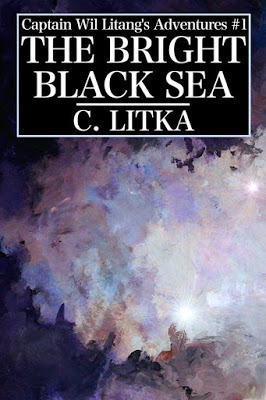
Version 3.3 (10 May 2016) of The Bright Black Sea is now available on Smashwords and Amazon. In the coming days it will trickle down to iBooks, B & N, and Kobo as well. I had hoped that version 3.0 would be the final one, but, alas, it proved not to be the case. However, thanks to R. Carlos, who read the story on his ipad, noted the errors he found and sent those notes along to me to fix, we now have a significantly better version. Between his 180 items, and going over the story again with MS Word's spell and grammar checker, I've squashed something like 200 “bugs” in the text. I'm sure that's the last of them. If you can prove me wrong, please do so. Send in any typos you find from version 3.3 to me at cmlitka@gmail.dom
I'd like to do print editions of my books, but I don't want to go that route until I'm confident that they're not riddled with typos. I gather print editions generally don't sell all that well, but I'm not in this for the money, so that doesn't matter. What matters is that I'd have print books, which would greatly simplify my Christmas gift giving… But this depends on how confident I am that my print books will be professional enough.
Version 3.3 also sports a slightly new cover again. I've added “Captain Wil Litang's Adventures #1” to the title, using my old cover art once again on all the versions.
Published on May 11, 2016 06:54
May 1, 2016
A Window to Self-Publishing
A Window to Self Publishing or the Wages of Free
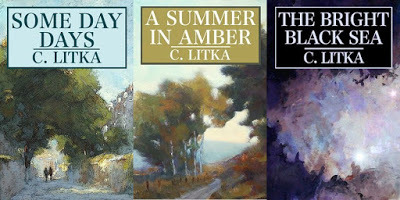
One year ago, on 27 April, 2015, I released my first novel, A Summer In Amber followed in July by a second, Some Day Days, and a third, The Bright Black Seain September. All were published on Smashwords and Amazon, all were free on Smashwords and price-matched free on Amazon within a week of their release.
I'd like to share the results of my first year in self-publishing in the hope that my readers will find this window to the world of self-publishing interesting. Fellow authors may also find these results interesting, since I've conducted a pretty pure experiment in the potential and limitations of offering books for free to create or grow readership.
My rational for free was straightforward. As a new writer, I'd forgo royalties in exchange for readers. I had written the stories over the course of five years for the fun of writing with no intention of making money on them – if only because I wrote them to suit my own taste, which is not, as far as I can judge, very mainstream. All three books were released as science fiction, though none of them fit comfortably in any particular sub-genre. My space opera is not military s-f, my post-apocalyptic, steampunk story has neither zombies nor airships, and my little romance is not a conventional commercial romance – though I'm not a reader of popular romances so I can't say that for certain.
Beyond starting this blog, I lifted not a finger to promote them. My business plan was to publish them and let lightning strike. Which is not a business plan. It is, however, all I cared to do. Anything more would have been work and this is all about having fun writing stories, and having fun publishing them. Nothing more. These results can be seen as a test of what pure "free" can achieve.
The Books and Their Numbers
I should make it clear that the numbers reported below are for free downloads, not sales. Anyone who downloads a "sample" gets the whole book. My books have been on sale at list price on Amazon's foreign sites, and for the last 6 weeks, The Bright Black Sea has been at full price on Amazon's US store as well. The total for these actual sales is in the low double digits.
Books published on Smashwords are also distributed to Barnes & Noble, iBooks, and Kobo. Kobo does not report download numbers of free books, so the totals are somewhat under reported.
Rather than reporting exact numbers for each store, I'll report the combined downloads. The ratio of Amazon downloads to the Smashwords versions varies by title, but taken as a whole, the combined Smashwords downloads were something like double Amazon's downloads.
I've also listed the number of review and ratings for each title. Rating and reviews from Amazon (A), Smashwords (S), iBooks (iBK), Barnes & Noble (B&N), Kobo (K) and Goodreads (GR).
A Summer in Amber A mystery/adventure/romance set in a post-apocalyptic Scotland. A mirror-image steampunk story with 19th century tech transposed to the late 21st century after solar storms lay waste to power grids, satellites and digital devices.
Released 27 April 2015 (Free on Smashwords, $.99 on Amazon, price matched in about a week. List price changed to $2.99 in March. Has been free on Amazon UK for several months.)Days on the market: 368 Downloads to 1 May 2016: 2222Average downloads per day: 6 (April average: 2.7)Reviews and/or ratings: 33 Downloads per rating/review: 82 A S iBK B&N K GR Total5 star 9 0 2 1 0 1 134 star 4 4 3 0 3 2 163 star 0 0 0 0 0 0 02 star 1 0 0 0 0 3 41 star 0 0 0 0 0 0 0Total 14 4 5 1 3 6 33
Released in Science Fiction Steampunk & Adventure, changed to Steampunk and post-apocalyptic after Feb 2016. (Amazon rating include 2 at Amazon UK)
Some Day DaysA new adult romance and exploration of technology set in Oxford & Cambridge in the not too distant future. Somewhat experimental in style & structure. A collection of "pieces" that are the start of a never to be written much longer story.
Released 9 July 2015 (Free on Smashwords, $.99 on Amazon before price matching. List price changed to $1.99 1 March 2016 Full price outside of Amazon.com)Days on the market: 296Downloads and sales to 1 May 2016: 1139Average downloads per day: 3.8 (April average: 2 )Reviews and/or ratings; 5 (including one none starred one)Downloads per rating/review 570 A S iBK B&N K GR Total5 star 0 0 0 0 0 0 04 star 0 1 0 0 0 1 23 star 0 0 0 0 0 1 12 star 0 0 0 0 0 1 11 star 0 0 0 0 0 0 0Total 0 1 0 0 0 3 4
Released in Science Fiction romance & Romance, changed to Literature & New Adult Romance after Feb 2016
The Bright Black Sea A long, 325,000 word, old-school inspired space opera/adventure/mystery. Began as a serial, written in three novel-length parts, and released in a single volume since there was no financial incentive to stretch it into a trilogy.
Released 16 Sept 2015 (Free on Smashwords, $.99 Amazon until price matched. List price changed to $3.99 1 March 2016. Full price outside of Amazon.com. Amazon dropped price matching on 9 March so it is now available at list price.)Days on the market: 227Downloads & sales to 1 May 2016: 3176 Average downloads per day: 14 (April average [including Amazon sales]: 5 )Reviews and/or ratings: 80 (The 2 non-starred reviews were positive reviews.) Downloads per rating/review 45 A S iBK B&N K GR Totalnon-starred 2 25 star 11 6 30 3 0 9 594 star 5 2 3 1 1 0 123 star 0 0 4 0 0 0 42 star 0 0 0 0 0 1 11 star 0 0 2 0 0 0 2Total 16 10 39 4 1 10 80
Released as Science Fiction Space Opera & Science Fiction. Since Amazon stopped price matching this book, it sells a copy or so a week. I'll let it ride at $3.99 for now while awaiting that lightning strike.
Total downloads and sales reported for the year: 6,537 copies.
Let's compare this result to the ebook market as a whole.
The ebook Marketplace
In traditional publishing, a book that sells 10,000 copies is considered a successful book. In the past, at least, it would likely earn the author a contract for a second book. Thus, by traditional publishing standards, even overlooking the fact that I was just giving away the books, all failed to make the grade in a traditional publishing in their release year (to date). However, that market includes paper books sold in bookstores as well as online, so those books receive far greater exposure (for a month) with traditional publishing.
So how did my books fare compared to the online only ebook market, and the self-publishing market in particular?
I'll use Amazon's ebook sales as generated by Author Earnings's Feb. 2016 report as my basis for comparison, since they provide hard numbers and data based estimates. You can view their report here:http://authorearnings.com/report/february-2016-author-earnings-report/
Authors provide sales and ranking data to AuthorEarnings who then use this data to reverse engineer how Amazon ranks each book. Once a quarter, on a single day, AuthorEarnings collect the sales rankings from all the books listed on Amazon's many "100 Best Selling Books" lists and use this data to estimate sales volume and the actual sales of each book on those lists on that day. This captures data on 200,000 ebooks.
The information from their Feb 2016 sample is displayed on the graph below. The green and grey dots represent author supplied data.
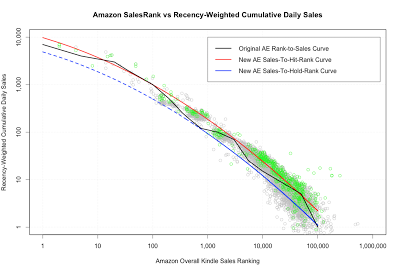
Note that this is a logarithmic graph. While it nicely displays their data points, it presents a very distorted visual view of actual sales. A linear graph of the same data would look something like this:
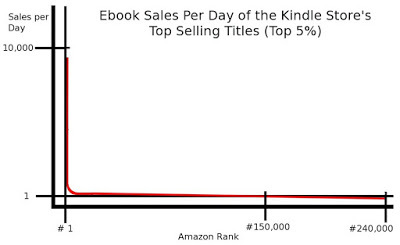
Using numbers from these graphs, we can estimate the sales range for ebooks in the various levels of ranking:
Sales Rank number of titles sales per day sales per year at day rate #1 to #10 10 8000 to 3000 2.92 million to 1.10 million#11 to #100 90 3000 to 1000 1.10 million to 365,000#101 to #1000 900 1000 to 200 365,000 to 73,000#1001 to #10,000 9,000 200 to 25 73,000 to 9,125#10,001 to #100,000 90,000 25 to 2 9,125 to 730#100,001 to #150,000 50,000 2 to 1 750 to 365#150,000 to #200,000 90,000 1 or less 365 or less
These 200,000 titles represent about 5% of the 4+ million ebooks Amazon currently offers in the Kindle Store and about 6% to 7% of the ebook authors. To put it in better perspective, 95% of all the ebooks Amazon offers likely sell fewer than 365 copies in a year.
These figures include the ebooks of traditionally published authors as well as self-published ones. Self-published books and single author publishers make up 39% of the top 5% of Amazon bestsellers. Their books account for 47% of the daily sales volume, but only 27% of the sales in dollars, reflecting their generally lower price.
As for the market mix of genres, 77% of Smashwords' top 200 selling fiction titles are Romance (including YA Romance) with YA coming in second at about 11%. Detective stories and Fantasy are around 4% each and science fiction clocks in a 1%. Other categories are less popular. Most of these titles are self-published or small press. I've seen other figures that likely cover a broader sample of books and publishers that put science fiction at about 7% of the ebook market, placing it in 6th place, after Romance (16%) Paranormal (15%), Thriller (12%), Mystery (12%) and Fantasy (8%). Science fiction is a player in the ebook market, but far from a leader.
Amazon offers just under 300,000 science fiction ebooks in the Kindle store with almost 8,000 being released each month. About 4,500 science fiction books are offered for free.
The Money
Author Earnings found that 2.8% of Amazon authors or some 5,643 authors with books in the top 100 lists are making more than $10,000/year from their Amazon ebook sales alone. They estimate that there are "many" more authors earning this much who were not captured with their methods because their books were not in any top 100 list. More than half of the authors captured in this category were traditionally published authors. Less than 800 self-published authors were earning more than $25K per year, and a little more than 400 were earning $50K or more per year. It should be noted, this is gross royalties, not profit. Many self-publishing authors invest significant money producing their books. (More on this in a moment.)
To see how my books fared in this market, I will treat my downloads as "sales". A fantasy, and yet, a book in hand, is a book in hand no matter how it got there. And if building a readership is your primary goal, then distribution matter more than sales.
First, assuming all my books were "sold" exclusively on Amazon, how would they rank overall?A Summer in Amber sales/day 6 -- sales rank #20,000 to #40,000Some Day Days sales/day 4 -- sales rank #30,000 to #60,000The Bright Black Sea sales/day 14 -- sales rank #2,200 to #5,000
Using only books actually downloaded on Amazon we get:A Summer in Amber sales rank -- #50,000 to #100,000 Some Day Days sales rank -- #150,000 to #300,000The Bright Black Sea sales rank -- #27,000 to #55,000
Now lets put a money value to these "sales". I'll use Amazon's royalty rates for simplicity. For my total "sales" of 6537 copies I'd have earned for the year:@ $.99 x .35 $2,288@ $1.99 x .35 $4,553@ $2.99 x .70 $13,682@ $3.99 x .70 $18,258@ $4.99 x .70 $22,834@ $5.99 x .70 $27,410
The real numbers would likely have been far, far less. Smashwords' data suggests that about 41 copies of a free book are downloaded for every one sold. Dividing my total "sales" by 41, gives us a more realistic royalty figure in the range of $55 to $668 with the low figure being the more likely one.
Clearly I left very little money on the table by giving my books away. In return, I achieved a circulation level in the upper 2.5% of all ebooks. If my free downloaded books been sold at $2.99, I would've been one of the elite self-published authors making more than $10,000 a year in ebooks – in, mind you, my first year of publishing, starting from a readership of zero. Outside of romance, how likely would one achieve results like these, and at what financial cost?
Which brings us to the flip side to sales – the expenses involved in publishing professional quality ebooks. A lot of money can be spent on preparing a book to be published. There are all sorts of editors, book coaches, proofreaders, cover artists, and book designers offering services to authors. There are also a great variety of advertising and promotional services available to get a book noticed. Authors travel to book fairs and conventions at their expense to meet readers and promote their book. And they can pay to attend seminars or take classes to improve their skills. Most experts suggests that authors avail themselves of at least some of these services to increase their chance of success.
I did everything in house so my expenses were $0.00, and considering that I actually, sold some books, I made a profit in my first year of self-publishing.
But let's say I followed the experts suggestions and hired professional help. I'll keep it to a minimum, “hiring” only a professional proofreader and a professional cover artist. Professional proof readers charge $.02- $.03 a word. Professional artists, $300 to $500 for a cover. Proofreading Art TotalsA Summer in Amber 115K $2,312/$3,468 $300/$500 $2,600/$3,968 Some Day Days 79K $1,530/$2,285 $300/$500 $1,830/$2,785The Bright Black Sea 326K $6,500/$9,780 $300/$500 $6,800/$10,280 Grand Total: $11,230 to $17,033
Had I hired these professionals, I would had to have sold, at the $.99 price point between 32,000 to 48,700 copies to cover my initial expenses. Or between 5,373 to 8,149 copies at the far more unlikely $2.99 price – to make as much money as I made going it alone and for free. Most likely I would have lost between $11,000 and $17,000 dollars, and since sales tend to fade, future sales would not likely do much cover these losses. Whether additional spending on promotional services would have narrowed the gap any is questionable, especially in the science fiction market.
Risking money on this scale for lightning-strike sales results, is not, in my opinion, a wise business decision. There is, of course, a price to be paid for foregoing these expenses in terms of reviews complaining of typos. However, I believe that with the lessons I've learned and new procedures I've put in place, I'll be able to produce future books with far fewer typos right from the start. But there will likely still be typos. They are the price of free.
Final Thoughts
Clearly, releasing initial books for free, especially without any sort of financial investment or marketing, has definite limitations. It takes you only so far. Still, the results, in terms of distribution, are significant.
From my perspective, I think the results are very positive. I made a profit. Without even trying. I did what was necessary, but avoided all the aspects of self-publishing that I wouldn't care to touch with a bargepole while still placing my books into circulation at a level equal to the top 2.5% of Amazon ebook titles. By publishing my books in all available markets, I tripled my sales over going exclusively with Amazon. Those million plus self-published titles tied up in Amazon's Kindle Unlimited Program may have soaked up a lot of excess inventory from other ebook stores, making discovery a little easier outside of Amazon.
I've seen it said that free books are less likely to be read than purchased ones. I've also read that one can expect a review on Amazon for every 100 to 200 books purchased, with 1 in 150 mentioned several times. Using this measure and only Amazon downloads and reviews, A Summer in Amberwas reviewed once for every 67 downloads and The Bright Black Sea 1 in 63 downloads, suggesting to me that they were read just as often as purchased books. Circulation is circulation.
The path I've chosen suits me. I'm happy that my work has been generally well received. That's a great relief, since there was no guarantee readers would like my stories. I hear of first time authors who can count the sales of their book on the fingers of two hands, and give almost every buyer a name as well, so that my 6,500+ books and 110+ ratings is not a bad beginning.
Now, I've no intention of getting into the business of self-publishing – this is just a hobby for me – so that turning the corner to start actually selling books is not a concern of mine. I would think, however, that I'd be looking at downloads over 10,000 copies before I'd make the move. And that may well take several years and half a dozen free books to achieve, if all goes well.
So this, then, is my first annual report. Next year's report should be interesting as well, since I don't have plans to release a new book in 2016. We'll be able to see how sustainable free is over time. (This, by the way, is also not a good business plan, but I like writing long books, and rather than break them up, I'd rather publish them as complete novels, so the next 300K+ novel won't be out until sometime in 2017.)
So, success or failure? Smart or stupid? Any ideas or suggestions? Let me know in the comments below or via email.

One year ago, on 27 April, 2015, I released my first novel, A Summer In Amber followed in July by a second, Some Day Days, and a third, The Bright Black Seain September. All were published on Smashwords and Amazon, all were free on Smashwords and price-matched free on Amazon within a week of their release.
I'd like to share the results of my first year in self-publishing in the hope that my readers will find this window to the world of self-publishing interesting. Fellow authors may also find these results interesting, since I've conducted a pretty pure experiment in the potential and limitations of offering books for free to create or grow readership.
My rational for free was straightforward. As a new writer, I'd forgo royalties in exchange for readers. I had written the stories over the course of five years for the fun of writing with no intention of making money on them – if only because I wrote them to suit my own taste, which is not, as far as I can judge, very mainstream. All three books were released as science fiction, though none of them fit comfortably in any particular sub-genre. My space opera is not military s-f, my post-apocalyptic, steampunk story has neither zombies nor airships, and my little romance is not a conventional commercial romance – though I'm not a reader of popular romances so I can't say that for certain.
Beyond starting this blog, I lifted not a finger to promote them. My business plan was to publish them and let lightning strike. Which is not a business plan. It is, however, all I cared to do. Anything more would have been work and this is all about having fun writing stories, and having fun publishing them. Nothing more. These results can be seen as a test of what pure "free" can achieve.
The Books and Their Numbers
I should make it clear that the numbers reported below are for free downloads, not sales. Anyone who downloads a "sample" gets the whole book. My books have been on sale at list price on Amazon's foreign sites, and for the last 6 weeks, The Bright Black Sea has been at full price on Amazon's US store as well. The total for these actual sales is in the low double digits.
Books published on Smashwords are also distributed to Barnes & Noble, iBooks, and Kobo. Kobo does not report download numbers of free books, so the totals are somewhat under reported.
Rather than reporting exact numbers for each store, I'll report the combined downloads. The ratio of Amazon downloads to the Smashwords versions varies by title, but taken as a whole, the combined Smashwords downloads were something like double Amazon's downloads.
I've also listed the number of review and ratings for each title. Rating and reviews from Amazon (A), Smashwords (S), iBooks (iBK), Barnes & Noble (B&N), Kobo (K) and Goodreads (GR).
A Summer in Amber A mystery/adventure/romance set in a post-apocalyptic Scotland. A mirror-image steampunk story with 19th century tech transposed to the late 21st century after solar storms lay waste to power grids, satellites and digital devices.
Released 27 April 2015 (Free on Smashwords, $.99 on Amazon, price matched in about a week. List price changed to $2.99 in March. Has been free on Amazon UK for several months.)Days on the market: 368 Downloads to 1 May 2016: 2222Average downloads per day: 6 (April average: 2.7)Reviews and/or ratings: 33 Downloads per rating/review: 82 A S iBK B&N K GR Total5 star 9 0 2 1 0 1 134 star 4 4 3 0 3 2 163 star 0 0 0 0 0 0 02 star 1 0 0 0 0 3 41 star 0 0 0 0 0 0 0Total 14 4 5 1 3 6 33
Released in Science Fiction Steampunk & Adventure, changed to Steampunk and post-apocalyptic after Feb 2016. (Amazon rating include 2 at Amazon UK)
Some Day DaysA new adult romance and exploration of technology set in Oxford & Cambridge in the not too distant future. Somewhat experimental in style & structure. A collection of "pieces" that are the start of a never to be written much longer story.
Released 9 July 2015 (Free on Smashwords, $.99 on Amazon before price matching. List price changed to $1.99 1 March 2016 Full price outside of Amazon.com)Days on the market: 296Downloads and sales to 1 May 2016: 1139Average downloads per day: 3.8 (April average: 2 )Reviews and/or ratings; 5 (including one none starred one)Downloads per rating/review 570 A S iBK B&N K GR Total5 star 0 0 0 0 0 0 04 star 0 1 0 0 0 1 23 star 0 0 0 0 0 1 12 star 0 0 0 0 0 1 11 star 0 0 0 0 0 0 0Total 0 1 0 0 0 3 4
Released in Science Fiction romance & Romance, changed to Literature & New Adult Romance after Feb 2016
The Bright Black Sea A long, 325,000 word, old-school inspired space opera/adventure/mystery. Began as a serial, written in three novel-length parts, and released in a single volume since there was no financial incentive to stretch it into a trilogy.
Released 16 Sept 2015 (Free on Smashwords, $.99 Amazon until price matched. List price changed to $3.99 1 March 2016. Full price outside of Amazon.com. Amazon dropped price matching on 9 March so it is now available at list price.)Days on the market: 227Downloads & sales to 1 May 2016: 3176 Average downloads per day: 14 (April average [including Amazon sales]: 5 )Reviews and/or ratings: 80 (The 2 non-starred reviews were positive reviews.) Downloads per rating/review 45 A S iBK B&N K GR Totalnon-starred 2 25 star 11 6 30 3 0 9 594 star 5 2 3 1 1 0 123 star 0 0 4 0 0 0 42 star 0 0 0 0 0 1 11 star 0 0 2 0 0 0 2Total 16 10 39 4 1 10 80
Released as Science Fiction Space Opera & Science Fiction. Since Amazon stopped price matching this book, it sells a copy or so a week. I'll let it ride at $3.99 for now while awaiting that lightning strike.
Total downloads and sales reported for the year: 6,537 copies.
Let's compare this result to the ebook market as a whole.
The ebook Marketplace
In traditional publishing, a book that sells 10,000 copies is considered a successful book. In the past, at least, it would likely earn the author a contract for a second book. Thus, by traditional publishing standards, even overlooking the fact that I was just giving away the books, all failed to make the grade in a traditional publishing in their release year (to date). However, that market includes paper books sold in bookstores as well as online, so those books receive far greater exposure (for a month) with traditional publishing.
So how did my books fare compared to the online only ebook market, and the self-publishing market in particular?
I'll use Amazon's ebook sales as generated by Author Earnings's Feb. 2016 report as my basis for comparison, since they provide hard numbers and data based estimates. You can view their report here:http://authorearnings.com/report/february-2016-author-earnings-report/
Authors provide sales and ranking data to AuthorEarnings who then use this data to reverse engineer how Amazon ranks each book. Once a quarter, on a single day, AuthorEarnings collect the sales rankings from all the books listed on Amazon's many "100 Best Selling Books" lists and use this data to estimate sales volume and the actual sales of each book on those lists on that day. This captures data on 200,000 ebooks.
The information from their Feb 2016 sample is displayed on the graph below. The green and grey dots represent author supplied data.

Note that this is a logarithmic graph. While it nicely displays their data points, it presents a very distorted visual view of actual sales. A linear graph of the same data would look something like this:

Using numbers from these graphs, we can estimate the sales range for ebooks in the various levels of ranking:
Sales Rank number of titles sales per day sales per year at day rate #1 to #10 10 8000 to 3000 2.92 million to 1.10 million#11 to #100 90 3000 to 1000 1.10 million to 365,000#101 to #1000 900 1000 to 200 365,000 to 73,000#1001 to #10,000 9,000 200 to 25 73,000 to 9,125#10,001 to #100,000 90,000 25 to 2 9,125 to 730#100,001 to #150,000 50,000 2 to 1 750 to 365#150,000 to #200,000 90,000 1 or less 365 or less
These 200,000 titles represent about 5% of the 4+ million ebooks Amazon currently offers in the Kindle Store and about 6% to 7% of the ebook authors. To put it in better perspective, 95% of all the ebooks Amazon offers likely sell fewer than 365 copies in a year.
These figures include the ebooks of traditionally published authors as well as self-published ones. Self-published books and single author publishers make up 39% of the top 5% of Amazon bestsellers. Their books account for 47% of the daily sales volume, but only 27% of the sales in dollars, reflecting their generally lower price.
As for the market mix of genres, 77% of Smashwords' top 200 selling fiction titles are Romance (including YA Romance) with YA coming in second at about 11%. Detective stories and Fantasy are around 4% each and science fiction clocks in a 1%. Other categories are less popular. Most of these titles are self-published or small press. I've seen other figures that likely cover a broader sample of books and publishers that put science fiction at about 7% of the ebook market, placing it in 6th place, after Romance (16%) Paranormal (15%), Thriller (12%), Mystery (12%) and Fantasy (8%). Science fiction is a player in the ebook market, but far from a leader.
Amazon offers just under 300,000 science fiction ebooks in the Kindle store with almost 8,000 being released each month. About 4,500 science fiction books are offered for free.
The Money
Author Earnings found that 2.8% of Amazon authors or some 5,643 authors with books in the top 100 lists are making more than $10,000/year from their Amazon ebook sales alone. They estimate that there are "many" more authors earning this much who were not captured with their methods because their books were not in any top 100 list. More than half of the authors captured in this category were traditionally published authors. Less than 800 self-published authors were earning more than $25K per year, and a little more than 400 were earning $50K or more per year. It should be noted, this is gross royalties, not profit. Many self-publishing authors invest significant money producing their books. (More on this in a moment.)
To see how my books fared in this market, I will treat my downloads as "sales". A fantasy, and yet, a book in hand, is a book in hand no matter how it got there. And if building a readership is your primary goal, then distribution matter more than sales.
First, assuming all my books were "sold" exclusively on Amazon, how would they rank overall?A Summer in Amber sales/day 6 -- sales rank #20,000 to #40,000Some Day Days sales/day 4 -- sales rank #30,000 to #60,000The Bright Black Sea sales/day 14 -- sales rank #2,200 to #5,000
Using only books actually downloaded on Amazon we get:A Summer in Amber sales rank -- #50,000 to #100,000 Some Day Days sales rank -- #150,000 to #300,000The Bright Black Sea sales rank -- #27,000 to #55,000
Now lets put a money value to these "sales". I'll use Amazon's royalty rates for simplicity. For my total "sales" of 6537 copies I'd have earned for the year:@ $.99 x .35 $2,288@ $1.99 x .35 $4,553@ $2.99 x .70 $13,682@ $3.99 x .70 $18,258@ $4.99 x .70 $22,834@ $5.99 x .70 $27,410
The real numbers would likely have been far, far less. Smashwords' data suggests that about 41 copies of a free book are downloaded for every one sold. Dividing my total "sales" by 41, gives us a more realistic royalty figure in the range of $55 to $668 with the low figure being the more likely one.
Clearly I left very little money on the table by giving my books away. In return, I achieved a circulation level in the upper 2.5% of all ebooks. If my free downloaded books been sold at $2.99, I would've been one of the elite self-published authors making more than $10,000 a year in ebooks – in, mind you, my first year of publishing, starting from a readership of zero. Outside of romance, how likely would one achieve results like these, and at what financial cost?
Which brings us to the flip side to sales – the expenses involved in publishing professional quality ebooks. A lot of money can be spent on preparing a book to be published. There are all sorts of editors, book coaches, proofreaders, cover artists, and book designers offering services to authors. There are also a great variety of advertising and promotional services available to get a book noticed. Authors travel to book fairs and conventions at their expense to meet readers and promote their book. And they can pay to attend seminars or take classes to improve their skills. Most experts suggests that authors avail themselves of at least some of these services to increase their chance of success.
I did everything in house so my expenses were $0.00, and considering that I actually, sold some books, I made a profit in my first year of self-publishing.
But let's say I followed the experts suggestions and hired professional help. I'll keep it to a minimum, “hiring” only a professional proofreader and a professional cover artist. Professional proof readers charge $.02- $.03 a word. Professional artists, $300 to $500 for a cover. Proofreading Art TotalsA Summer in Amber 115K $2,312/$3,468 $300/$500 $2,600/$3,968 Some Day Days 79K $1,530/$2,285 $300/$500 $1,830/$2,785The Bright Black Sea 326K $6,500/$9,780 $300/$500 $6,800/$10,280 Grand Total: $11,230 to $17,033
Had I hired these professionals, I would had to have sold, at the $.99 price point between 32,000 to 48,700 copies to cover my initial expenses. Or between 5,373 to 8,149 copies at the far more unlikely $2.99 price – to make as much money as I made going it alone and for free. Most likely I would have lost between $11,000 and $17,000 dollars, and since sales tend to fade, future sales would not likely do much cover these losses. Whether additional spending on promotional services would have narrowed the gap any is questionable, especially in the science fiction market.
Risking money on this scale for lightning-strike sales results, is not, in my opinion, a wise business decision. There is, of course, a price to be paid for foregoing these expenses in terms of reviews complaining of typos. However, I believe that with the lessons I've learned and new procedures I've put in place, I'll be able to produce future books with far fewer typos right from the start. But there will likely still be typos. They are the price of free.
Final Thoughts
Clearly, releasing initial books for free, especially without any sort of financial investment or marketing, has definite limitations. It takes you only so far. Still, the results, in terms of distribution, are significant.
From my perspective, I think the results are very positive. I made a profit. Without even trying. I did what was necessary, but avoided all the aspects of self-publishing that I wouldn't care to touch with a bargepole while still placing my books into circulation at a level equal to the top 2.5% of Amazon ebook titles. By publishing my books in all available markets, I tripled my sales over going exclusively with Amazon. Those million plus self-published titles tied up in Amazon's Kindle Unlimited Program may have soaked up a lot of excess inventory from other ebook stores, making discovery a little easier outside of Amazon.
I've seen it said that free books are less likely to be read than purchased ones. I've also read that one can expect a review on Amazon for every 100 to 200 books purchased, with 1 in 150 mentioned several times. Using this measure and only Amazon downloads and reviews, A Summer in Amberwas reviewed once for every 67 downloads and The Bright Black Sea 1 in 63 downloads, suggesting to me that they were read just as often as purchased books. Circulation is circulation.
The path I've chosen suits me. I'm happy that my work has been generally well received. That's a great relief, since there was no guarantee readers would like my stories. I hear of first time authors who can count the sales of their book on the fingers of two hands, and give almost every buyer a name as well, so that my 6,500+ books and 110+ ratings is not a bad beginning.
Now, I've no intention of getting into the business of self-publishing – this is just a hobby for me – so that turning the corner to start actually selling books is not a concern of mine. I would think, however, that I'd be looking at downloads over 10,000 copies before I'd make the move. And that may well take several years and half a dozen free books to achieve, if all goes well.
So this, then, is my first annual report. Next year's report should be interesting as well, since I don't have plans to release a new book in 2016. We'll be able to see how sustainable free is over time. (This, by the way, is also not a good business plan, but I like writing long books, and rather than break them up, I'd rather publish them as complete novels, so the next 300K+ novel won't be out until sometime in 2017.)
So, success or failure? Smart or stupid? Any ideas or suggestions? Let me know in the comments below or via email.
Published on May 01, 2016 10:38
April 30, 2016
The Lost Star's Sea Update
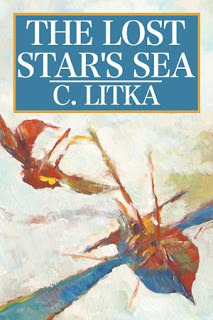
The bad news: I've decided to push back the release of The Lost Star's Sea until mid-2017.The good news: I've decided to release the complete story instead of only Part One this fall and Part Two at some later date.
This decision came about after finishing the second draft of Part One. I felt disappointed in it after reading through it this last month. It just wasn't “it”. And if I felt this way, I'm pretty sure you'd be disappointed too. Luckily I don't think the reason is what I've written, but what I've not written.
I intended to split The Lost Star's Sea in two parts. The first would cover Wil Litang initial adventures as a shipwrecked spaceer in the endless skies of the Pela, and how he managed to survive and made a new life for himself in the Pela. Part Two would then shake that life up by bringing back the lingering questions and loose threads from The Bright Black Sea and questions raised in Part One. That, however, isn't going to work. I found that only half the story isn't enough, even though I had it ending a inportant story arc. Or maybe because of it, since that ending struck me as trite and cheesy. Too easy.
The thing is, this story continues the episodic pattern from the first volume, which is to say, a series of semi-self-contained stories. Part One has 3 to 5 of them (depending on how you divide them). This works best if each episode builds on the larger story arc. But if that larger story arc is not very evident, as it is in Part One, then it becomes just a flat recital of this adventure ant that adventure. (I'm not known for brevity in my writing, and this book will be no exception, evident by the fact that I'm 180K+ words into the story and am still laying the ground work, so to speak.) While I hope this series of adventures are interesting in themselves, they do not address the questions left hanging at the end of The Bright Black Sea and when I came to the end of my revisions, I felt sort of cheated – I'd been promised a story, but only given half of one. I'm not going to settle for that.
And if I felt that way, I could only imagine how you might feel. This is especially true since I've only come to realize that The Lost Star's Sea might not be the book you're expecting. I knew what I wanted to do with the next book halfway though writing the last one, but I'm not sure that I telegraphed that in the story. (Not that I wanted to.) So that if the story doesn't start out like you expect and then ends before what you expected ever appears, well, I don't think you'd be happy. I'm not going to risk that.
I realize that series writers do this all the time – stringing stories along, book by book for financial reasons. And readers, at least some of them, put up with this. I just came across a new fantasy series, Emperor of the Eight Islands, that is being published in four volumes – at $9.99 each for 270 page book – so that by the time readers reach the length of The Bright Black Sea, they'll have paid $40 for the story. This makes financial sense – assuming you can keep readers interested enough to reach the final volume, but my stories are not commercial endeavors (when I can help it), so I have no incentive to break my long novels into bite size pieces. I can afford to present them in the best way possible, as a complete story.
By deciding to publish the whole story in one volume, I now must begin daydreaming up what happens in the second half of the story, something I'd not ventured to do until now. It can be hard. When you're half a million words into a story, the characters no longer do what you want them to. They have character. And I'm a stickler for avoiding plot holes. Action must flow naturally. Characters may occasionally do ill advised things, but they can't do obviously stupid things just to make a nice scene. So coming up with a story involves a lot of “what-ifs?”. "Would they do that?" and then “Does it make sense?” I'm hoping to release the complete story by next summer, if all goes well. But you never know about that. It's the goal. Hopefully, it will be worth the wait.
Published on April 30, 2016 14:50
April 27, 2016
The Failed Art of The Bright Black Sea
For the last dozen years or so I've been painting landscape paintings. I've pretty much developed an impressionistic landscape style that is fairly unique. Not too popular, but unique. Which is what counts. This style, however, does not translate well into illustrations. It lacks detail and mine, at least often lack people. For A Summer in Amber and Some Day Days, I managed to do two landscapes, that while they're not really good cover illustrations, do at least set a tone for the stories. The Bright Black Sea has so far evaded my attempts to create a cover I like.
There are several reasons for this. First, as I mentioned, is that my style is vague on details, and most s-f book covers are big on details. Secondly, no matter how well designed the Lost Star is for it's environment, it lacks gee-galls and thingamajigs sticking out all over the place to make for an interesting cover illustration. The Lost Star is basically the most boring space ship imaginable, from every angle. It doesn't even have the fins like the old style rockets of s-f. Thirdly, being the author of the story, I know the story too well to just page through the book and find a scene that I care to do, irregardless of how important or unimportant that scene is in the story. A good cover might be one of the battle scenes, which have plenty of space ships and Star Wars type fighters. Throw in a bunch of explosions and you have a typical space opera cover. Except that episode plays only a small part of the story, and would be misleading, since The Bright Black Sea is not a military s-f book. I want to find something that represents the whole story, and that mostly comes back around to the Lost Star/Starry Shore. The boring old Lost Star without any thingamajigs.
Right now, the image I am using for my non-Amazon cover is this one:
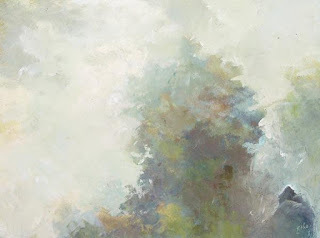
You simply need to inverse it, rotate and crop it get rid of that house in the corner and put in a few “nova” effects in Gimp and you have the cover – the Nine Star Nebula and a star or two.
I did, at one time, knock off some small sketches, but none turned out good enough to use:
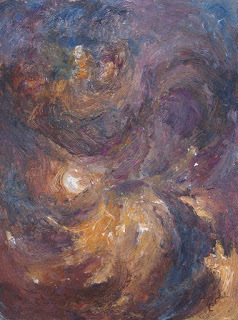
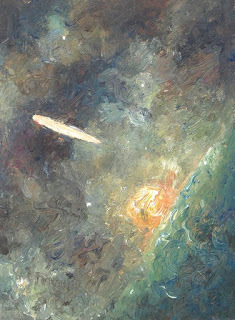
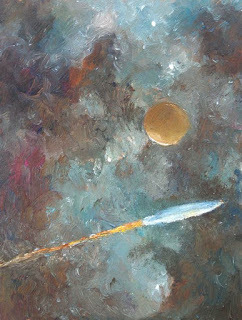
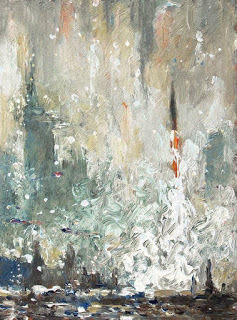
The four pieces above were all little 6x8" sketches.
I also made several attempts to do a cover with the Lost Star more than a speck in the painting, neither of them made the grade:
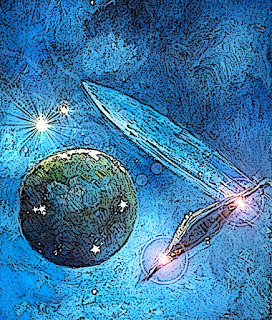
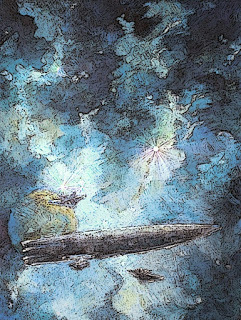
In these cases, I used filters in Gimp to give them some additional and some lighting effects as well. As I said, both turned out looking too crude and amateurish. The one I'm using for my Amazon cover is another painting using Gimp filters, but does not have a crude space ship in it.
Recently, I tried one with people instead of the ship -- a scene from the Lost Star's bridge. As you can see below, it did not go well. Still way too amateurish. Not professional looking at all. But there was one other problem, and for me, a greater problem -- I don't want to define how my characters look. I want to leave that up to you, the readers.
In part this reflects a quirk in the way my mind works. I can't picture living people in my mind. I recognize them, at least so far, but I can't picture them. I have a little bit better luck picturing photos of people, but still, it's pretty vague. Not surprisingly then, I have no images of my characters in my head, just vague impressions of them. I'd probably recognize them if I met them, but I can't picture them. So rather than just listing a bunch of characteristics for each that mean nothing to me, I keep my descriptions very sketchy, and you can ignore them if you choose. So by drawing for the cover, I was in some way defining them, which I do't want to do. These stories are set 80,000 years in the future and all the old earth ethnic types have long since been mixed and merged. Who knows what types have evolved in the long settled planets? The characters can look like whatever you want to look like. By making the cover below I felt I was compromising your freedom to imagine the crew of the Lost Star as you see them in your mind. As you can see, I tried to keep everyone as undefined as possible, and well, it didn't work out in any case. This image doesn't look like how I envision things, so it forget it after you look at it. Please.
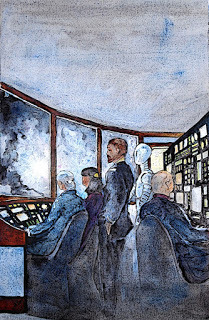
I haven't given up yet. 'm sure I'll make another effort or two. I might try the more graphical approach you see now days in covers. We'll see.
There are several reasons for this. First, as I mentioned, is that my style is vague on details, and most s-f book covers are big on details. Secondly, no matter how well designed the Lost Star is for it's environment, it lacks gee-galls and thingamajigs sticking out all over the place to make for an interesting cover illustration. The Lost Star is basically the most boring space ship imaginable, from every angle. It doesn't even have the fins like the old style rockets of s-f. Thirdly, being the author of the story, I know the story too well to just page through the book and find a scene that I care to do, irregardless of how important or unimportant that scene is in the story. A good cover might be one of the battle scenes, which have plenty of space ships and Star Wars type fighters. Throw in a bunch of explosions and you have a typical space opera cover. Except that episode plays only a small part of the story, and would be misleading, since The Bright Black Sea is not a military s-f book. I want to find something that represents the whole story, and that mostly comes back around to the Lost Star/Starry Shore. The boring old Lost Star without any thingamajigs.
Right now, the image I am using for my non-Amazon cover is this one:

You simply need to inverse it, rotate and crop it get rid of that house in the corner and put in a few “nova” effects in Gimp and you have the cover – the Nine Star Nebula and a star or two.
I did, at one time, knock off some small sketches, but none turned out good enough to use:




The four pieces above were all little 6x8" sketches.
I also made several attempts to do a cover with the Lost Star more than a speck in the painting, neither of them made the grade:


In these cases, I used filters in Gimp to give them some additional and some lighting effects as well. As I said, both turned out looking too crude and amateurish. The one I'm using for my Amazon cover is another painting using Gimp filters, but does not have a crude space ship in it.
Recently, I tried one with people instead of the ship -- a scene from the Lost Star's bridge. As you can see below, it did not go well. Still way too amateurish. Not professional looking at all. But there was one other problem, and for me, a greater problem -- I don't want to define how my characters look. I want to leave that up to you, the readers.
In part this reflects a quirk in the way my mind works. I can't picture living people in my mind. I recognize them, at least so far, but I can't picture them. I have a little bit better luck picturing photos of people, but still, it's pretty vague. Not surprisingly then, I have no images of my characters in my head, just vague impressions of them. I'd probably recognize them if I met them, but I can't picture them. So rather than just listing a bunch of characteristics for each that mean nothing to me, I keep my descriptions very sketchy, and you can ignore them if you choose. So by drawing for the cover, I was in some way defining them, which I do't want to do. These stories are set 80,000 years in the future and all the old earth ethnic types have long since been mixed and merged. Who knows what types have evolved in the long settled planets? The characters can look like whatever you want to look like. By making the cover below I felt I was compromising your freedom to imagine the crew of the Lost Star as you see them in your mind. As you can see, I tried to keep everyone as undefined as possible, and well, it didn't work out in any case. This image doesn't look like how I envision things, so it forget it after you look at it. Please.

I haven't given up yet. 'm sure I'll make another effort or two. I might try the more graphical approach you see now days in covers. We'll see.
Published on April 27, 2016 12:20
April 21, 2016
New Cover for the Bright Black Sea
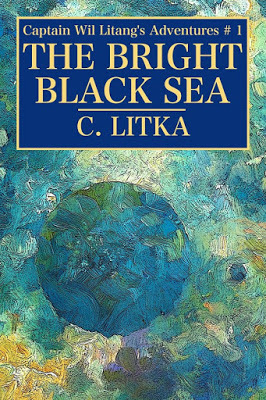 This is the new Amazon cover for The Bright Black Sea. Without price matching, I'm going to have to experiment to see what sells. I can't change the story, but I can change the cover. We'll start with this one. Unlike the last cover, this piece of art was something I did especially for the cover. I ended up choosing the other one because I felt that it fit better with The Bright Black Sea title I eventually chose. Both covers are too static, but the one I tried with the Lost Star on it sucked, as did the bridge scene one, so I'm still stuck with a static cover.
This is the new Amazon cover for The Bright Black Sea. Without price matching, I'm going to have to experiment to see what sells. I can't change the story, but I can change the cover. We'll start with this one. Unlike the last cover, this piece of art was something I did especially for the cover. I ended up choosing the other one because I felt that it fit better with The Bright Black Sea title I eventually chose. Both covers are too static, but the one I tried with the Lost Star on it sucked, as did the bridge scene one, so I'm still stuck with a static cover. I added the "Captain Wil Litang's Adventures #1" to the title, anticipating the second volume that will be released in the next four or five months.
In addition to the new cover, I've also re-written its blurb on Amazon. As a free book I didn't (and don't) feel I need to sell the book, if only because it doesn't matter how many copies are downloaded – I make the same amount of money. None. Instead, I wrote my blurbs with the idea of appealing to readers who would likely like the book while steering away people who likely wouldn't. But now I'm in the selling game, like it or not, I'll try selling the book to everyone. To that end I'm dropping the classic, golden age angle, and going with a straight space opera/space adventure pitch. We'll see how that works. Or not. It'll likely be hard to tell. Still, it's fun to experiment.
Published on April 21, 2016 19:27
April 15, 2016
Contact Information Update
It has been brought to my attention that the email address I had set up for this page doesn't work. Sorry about that. It seemed to work at the time I set it up. I have now changed it to one that I know works. cmlitka@gmail.com Please feel free to contact me with your comments or questions. I would like to hear from you.
Published on April 15, 2016 05:01



